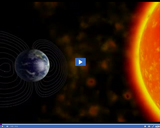
The magnetosphere protects Earth from the continual flow of charged particles from the sun, referred to as solar wind.
- Subject:
- Science
- Provider:
- Utah Education Network
- Author:
- Visual Learning Company
- Date Added:
- 02/28/2010

Resources created or licensed by the Utah Education Network

The magnetosphere protects Earth from the continual flow of charged particles from the sun, referred to as solar wind.

The placenta is a structure that enables the exchange of vital nutrients, oxygen, carbon dioxide, and wastes between the mother and the embryo.

Take an inside look of how the musical “Spike 150: As One” was made. Cast and crew members share their journey to make this historic musical a reality and what it means to give a voice to those who built the transcontinental railroad.

Conic projections are made by projecting a portion of a map onto a cone. Most road and weather maps are conic projections.
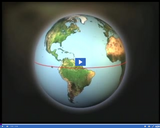
Lines of latitude run parallel to the equator, which is at zero degrees latitude. The north pole is 90 degrees north latitude and the south pole is 90 degrees south latitude.

The grid pattern formed by intersecting lines of latitude and longitude enable exact locations on Earth's surface to be pinpointed.

Imaginary lines that run from pole to pole are called meridians, or lines of longitude. The Prime Meridian, which passes through Greenwich, England, is zero degrees latitude. Locations west of the prime meridian are measured in degrees west.
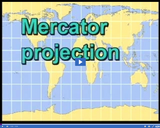
One of the most common projections of Earth is the Mercator projection which is very useful in navigation. One drawback is that land masses near the poles appear distorted.

The Earth makes one full rotation everyday. When the half facing the sun is lit (day), the other half is dark (night).

A time zone is a belt of longitude (approx. 15 degrees wide) in which all areas have the same time. There are 24 times zones.
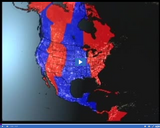
There are four time zones in the continental US.

This animated Math Shorts video explains absolute value, as demonstrated on the number line and through a real-life example. In the accompanying classroom activity, students watch the video and then play a game in which they move a penny along a number line in positive and negative directions. As they play, they use absolute value to track the total distance that the penny moves. To get the most from the lesson, students should be comfortable determining distance between positive and negative numbers on a number line.

This animated “Math Shorts” video explains the term additive inverse and provides several examples that demonstrate the concept. In the accompanying classroom activity, students create equations and solve problems that involve adding groups of negative and positive integers that sum to zero. To get the most out of this activity, students should be familiar with plotting positive and negative integers on a number line.
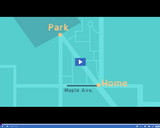
In this video

In this video, learn how to use division and place value to convert fractions to decimals. In the accompanying classroom activity, students watch the video to help them learn how to convert a fraction to a decimal using division. Then, they turn their attention to placing rational numbers on a number line. Practicing the placement of these numbers reinforces students’ number sense. It also gives them practice converting among the different representations of a single rational number.

This animated Math Shorts video explains how the distributive
property can help students model and create equivalent expressions. In the
accompanying classroom activity, students play a quick game where they identify
common factors within an expression and work on a series of problems that stretch their
understanding of how to apply the distributive property. While the problems begin with
whole number expressions, they soon work towards algebraic notation, and eventually
develop the idea that ax + bx can be rewritten as x(a + b).

In this Math Shorts video, learn how to solve problems that involve finding unknown angles of various types. In the accompanying classroom activity, students first review supplementary, complementary, vertical, and adjacent angles and then watch the video. Finally, students apply what they’ve learned by writing and solving equations that involve angle measurement, using algebraic notation to represent relationships among angles. To get the most from the lesson, students should be comfortable solving equations in the form ax = b.

In this video, learn how to find the greatest common factor of two numbers. Then, see how this can be used to solve problems with large numbers. In the accompanying classroom activity, students learn to find prime factors using factor trees. They then learn how prime factors, a Venn diagram, and simple multiplication can help them find the greatest common factor of two numbers. The lesson challenges students to find the greatest common factor of increasingly large numbers. It also pushes them to think about how prime factors are the building blocks of composite numbers.

In this video, learn how to use long division to divide large numbers. In the accompanying classroom activity, students learn how to use the standard long division algorithm. They explore alternative ways of thinking about long division by using place value to decompose three-digit numbers into hundreds, tens, and ones, creating three smaller (and less complex) division problems. Students then use these different solution methods in a short partner game.

In this video, learn how ratios, tables, and graphs can help identify proportional relationships. In the accompanying classroom activity, students use a classic mathematical task to improve their understanding of ratios and proportions. After watching the video and having a brief class discussion and review of ratios, students work in pairs to determine which of two punch mixtures tastes more like juice. This set of problems extends students' understanding of ratios while requiring them to use both multiplicative and additive reasoning in their responses.